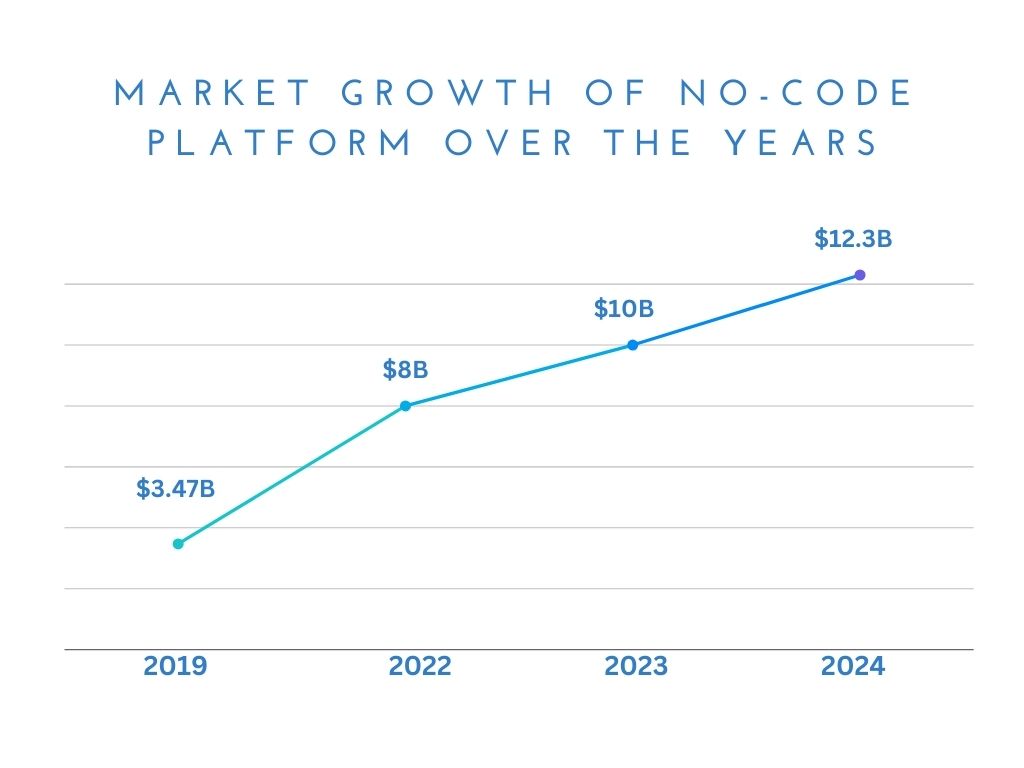Have you ever had an idea of developing something but lacked the coding skills to bring it to life? If so you are not the only one!
Developing software is complex and it requires you to be an experienced developer to achieve good results. But fear not! there is a term called “no-code” development that has been gaining significant popularity in the tech industry lately. Promising to revolutionize the way we create digital solutions by empowering individuals with little to no coding experience to develop functional digital solutions. While being extremely prominent and talked about in the industry, the question that arises the most is whether no code is truly the "next big thing"? And how will this be possible?
So in this blog, let's try to find the answer to this question while also finding out what is it and how is it possible.
What is No-Code?
No-Code is a revolutionary concept that is transforming the way people create software without the need for traditional programming. The term No-Code refers to a set of tools and platforms that enable individuals to build applications visually through a graphical user interface, eliminating the need for traditional programming. These platforms offer a range of pre-built components, templates, and drag-and-drop features that simplify the development process for non-technical users eliminating the skill barrier between people.
The Rise of the No-Code

The rise of no-code has been significantly greater over the past few years. According to Forbes, the no-code and low-code platform market grew from $3.47 billion in 2019 to $8 billion in 2022, with a forecasted increase to $10 billion in 2023 and $12.3 billion in 2024 (a 20% growth).
The market growth is expected to reach $182 billion by 2030, signifying its continued dominance in the tech industry. The market size is anticipated to expand further, and the forecasted growth indicates a strong trend toward the adoption of no-code and low-code platforms. Furthermore, a study reveals that 66% of businesses are expected to use low-code/no-code development by 2024, Microsoft anticipates that out of the 500 million apps expected to be created in the next five years, around 450 million will be designed using no-code or low-code platforms. These compelling statistics offer a clear perspective on the rapid and sustained growth of the no-code industry. Visit this article at Quixy for more no-code-related facts.
Why is No-Code Gaining Popularity?
With all the hype surrounding No-Code domination, let's delve into the main reasons why No-Code is gaining popularity.
Accessibility
The number one reason for its popularity is that no-code eliminates the technical barrier by making software development accessible to a wider audience. While there is still a place for coding, no-code development gives individuals a way to build applications more productively and efficiently. No-code platforms allow individuals without coding expertise to create applications using a visual interface and drag-and-drop blocks. This accessibility opens up app development to a wider range of people, including entrepreneurs, different businesses, and citizen developers. One notable platform that exemplifies the accessibility of no-code development is Webflow.
Speed and Efficiency
Traditional development can be time-consuming and resource-intensive. However, no-code platforms offer pre-built components and functionalities, allowing users to build quickly without the lengthy coding process. This enables rapid development cycles. Moreover, no-code platforms facilitate rapid prototyping, enabling teams to quickly test and iterate ideas. No-code platforms increase speed and efficiency during development, accelerating innovation and adaptation to changing market demands. According to studies, no-code and low-code solutions have the potential to reduce development time by up to 90%.
Addressing the skill gap
Another significant reason for its popularity is that it reduces the skill gap between individuals. No-code development is addressing the IT skills gap by empowering non-technical users to create software using a visual development approach, reducing the reliance on expert coding skills. This not only broadens the talent pool but also promotes cross-functional collaboration. According to ColorWhistle, by 2024, 80% of non-IT professionals will develop IT products and services, with over 65% using no-code tools.
Business Focus
No-code development enables businesses to focus on the core functionality of their application rather than delving into the complexities of coding. This frees up valuable resources and enables business users to participate in the development process. No-code development puts the spotlight on solving business challenges directly. With a visual interface and simplified workflows, teams can concentrate on addressing core business needs, fostering a more strategic approach to application development.
Complements Traditional Coding
No-Code does not aim to replace traditional coding practices but rather complements them. By offering visual interfaces, it allows users to create custom solutions without extensive coding knowledge. This approach integrates seamlessly with existing technologies, such as using Flutter plugins for WordPress, enhancing efficiency and flexibility in development processes.
Enhanced User Engagement and Customization
By streamlining the development process and providing pre-built templates and customizable options, no-code platforms enable increased user engagement. No-code platforms offer a wide range of customization options, allowing users to create applications that align precisely with their unique requirements. This emphasis on UI/UX design leads to more user-friendly and customized applications.
Democratization of Technology
No-code platforms democratize technology by empowering non-technical users to participate in the app development process. This shift allows businesses to involve a broader range of employees in the development process, reducing dependency on tech experts. With over 80% of enterprises turning towards no-code/low-code solutions, this trend highlights the importance of involving business users in app development.
Scalability and Cost Efficiency
One of the primary advantages of no-code platforms is their high scalability. The scalability of no-code solutions allows applications to grow seamlessly alongside user demands, ensuring their continued functionality. These platforms enable rapid development and deployment of applications, reducing time-to-market significantly. Moreover, no-code development offers a significantly lower cost barrier compared to traditional development methods. By eliminating the need for extensive coding, these platforms lower the cost barrier associated with software development, making it more accessible to businesses of all sizes.
Sustainability and Future Prospects
No-code platforms often leverage cloud-based infrastructure and efficient resource allocation, potentially contributing to a more sustainable future for technology development. The simplicity of no-code usage allows for broader employee involvement in the development process, fostering collaboration across different departments within organizations.
No-Code vs. Traditional Development
Here is a comparison between no-code and traditional development so you can have a better idea:
Comparison
No-code Development
Traditional Development
Speed of Development
Rapid prototyping and deployment with visual interfaces
Time-consuming coding processes often requiring deep understanding
Accessibility
Accessible to non-technical users; no coding skills required
Requires expertise in programming languages and frameworks
Cost
Cost-effective; eliminates the need for dedicated coding resources
Often entails higher costs due to hiring specialized developers
Flexibility
Offers scalability and flexibility without coding constraints
May face limitations in scalability and flexibility, especially in complex projects.
Learning curve
Minimal learning curve; visual interfaces streamline development
Steeper learning curve; requires proficiency in programming languages.
Customization
Limited customization options; rely on pre-built components
Offers extensive customization options for tailored solutions
Maintenance and Updates
Easier maintenance and updates; changes can be made through visual interfaces
Maintenance and updates may be complex, requiring extensive coding changes
Collaboration
Encourages collaboration among diverse teams and stakeholders.
Collaboration is often limited to technical experts and developers.
Agility
Supports agile development with quick iteration and experimentation
Development cycles may be slower, hindering agility and responsiveness.
Popular No-code Development Platforms
Platform
Description
A leading Website builder for No-code Development
Building Web and mobile apps without coding
Creating Mobile Apps with a Drag-and-Drop interface
Designing Responsive Websites with no coding required
Wix: A Leading Website Builder for No-Code Development
- User-friendly interface with powerful features.
- Drag-and-drop editor for creating stunning websites.
- Templates and customization options for various needs.
Bubble: Building Web and Mobile Apps Without Coding
- Intuitive drag-and-drop interface for designing apps.
- Visual workflow builder for complex logic and functionality.
- Suitable for building various types of applications.
Adalo: Creating Mobile Apps with a Drag-and-Drop Interface
- Specifically designed for building mobile apps.
- Simple drag-and-drop interface for app creation.
- Wide range of pre-built components and templates available.
Webflow: Designing Responsive Websites with No Coding Required
- Visual interface for building responsive websites.
- Powerful design tools for creating interactive experiences.
- Templates and customization options for diverse projects.
Examples of Successful No-Code Development Projects
Projects
Description
Popular automation tool connecting web applications.
Enables custom workflows without coding knowledge.
Flexible and collaborative database tool.
Combines spreadsheet ease with database power.
Allows the creation of mobile apps from Google Sheets data.
Simple and intuitive interface for app development.
Interesting Fact!
Zee Palm’s Website is also built on a no-code platform, webflow.
Limitations Of No-Code Development
Despite the potential of no-code development, acknowledging its limitations is crucial for making informed decisions and choosing the right approach according to your project’s needs. Let’s have a closer look at the challenges of no-code development.
Template Dependence
No-code platforms often offer a range of templates and pre-built components to facilitate rapid development. However, reliance on these templates can limit the design flexibility and uniqueness of the end product.
For instance, While you can build a visually appealing website with Webflow using their templates, creating a unique and non-templated e-commerce platform like Shopify might be significantly more challenging due to limitations in building custom functionalities like complex product filtering, advanced shopping carts, and integrated payment gateways.
Security Concerns
Security is a critical consideration in any software development process. No-code platforms, while convenient, may introduce security vulnerabilities if not properly managed.
In 2021, a security breach in a popular no-code platform Bubble exposed user data. While the platform addressed the issue promptly, it highlights the importance of understanding the security measures and practices of any no-code platform you choose.
Scalability Trade-offs
While some no-code platforms are capable of handling significant traffic and data volume, they might not be suitable for applications with extreme scalability needs. Evaluate the scalability requirements of your project and choose a platform that can accommodate future growth and demands.
a social media platform like Facebook that needs to handle millions of users and massive data volume might not be feasible using a no-code platform due to potential limitations in handling such high demands.
Limited Support and Maintainance
While some no-code platforms provide robust support and maintenance options, others may offer limited assistance or require additional fees for extended support. Research the platform's support options and consider the cost and availability of additional maintenance services if needed.
Time to Market Compromises
While no-code platforms can be faster than traditional coding, achieving a feature-rich and complex application might still require significant time and effort.
Building a complex mobile game with advanced graphics and intricate gameplay mechanics might take longer to develop even with a no-code platform like Adalo compared to building it with native coding tools due to potential limitations in replicating specific functionalities and performance requirements.
Creative Limitations
No-code platforms may present some limitations in terms of achieving highly creative and unique functionalities compared to custom coding.
Building a music streaming platform with features like personalized recommendations based on emotional state or real-time music generation might be challenging with a no-code platform due to limitations in building such complex algorithms and functionalities.
It's important to remember that these limitations are not deal-breakers for everyone. By carefully considering your specific needs and priorities, you can determine if no-code development is the right solution for your project and leverage its benefits while mitigating potential challenges.
Resources and Learning Material
The no-code landscape is constantly evolving, with new platforms, tools, and resources emerging regularly. Here's a comprehensive guide to equip you with the knowledge and skills to navigate through your No-code journey.
Online Courses and Tutorials
- No Code MBA offers a variety of in-depth courses on popular no-code platforms like Webflow, Bubble, and Airtable. These courses are well-structured, beginner-friendly, and taught by industry experts.
- Buildspace creates educational content on various no-code platforms, including Webflow, Bubble, and Adalo. They offer tutorials, project walkthroughs, and tips for beginners through their YouTube channel and other online platforms.
- Nocodify Academy offers a range of tutorials, articles, and community resources designed to help individuals learn no-code development. They also have a forum where you can connect with other no-code developers and ask questions.
Community Forums
- NoCode Reddit a vibrant community where you can ask questions, share ideas, and learn from other no-code developers. Join discussions, find inspiration, and stay updated on the latest trends in the no-code space.
- Bubble Forum the official forum for the Bubble platform. Get support from the Bubble community, access troubleshooting guides, and learn from experienced Bubble developers.
Books and Articles
- “No Code: The Power of Without Code" by Chris Benson explores the potential of no-code development and offers practical advice for building applications without coding.
- "Low-Code/No-Code Revolution: Leverage Citizen Developers to Drive Innovation" by Bernard Broy examines the impact of low-code/no-code on businesses and how organizations can leverage these tools to innovate.
Future of No-Code
The future of no-code development is bright, poised to revolutionize software creation and democratize access to technology. As the technology matures, we can expect:
- Enhanced user experiences and capabilities within no-code platforms.
- Deeper integration with advanced technologies like AI and ML.
- Democratization of development, enabling businesses of all sizes to innovate without large development teams.
- Heightened focus on security and governance to ensure responsible development.
In summary, no-code development holds tremendous potential to empower individuals and businesses, reshaping the future of software development across industries while complementing traditional development methodologies. Will it completely replace traditional development? That’s debatable, Only time will tell what the future holds for us.
If you want to see similar blogs like this, you can visit our website at Zee Palm.
Here is a link to one of our blogs discussing Onboarding with No-code Automation.








